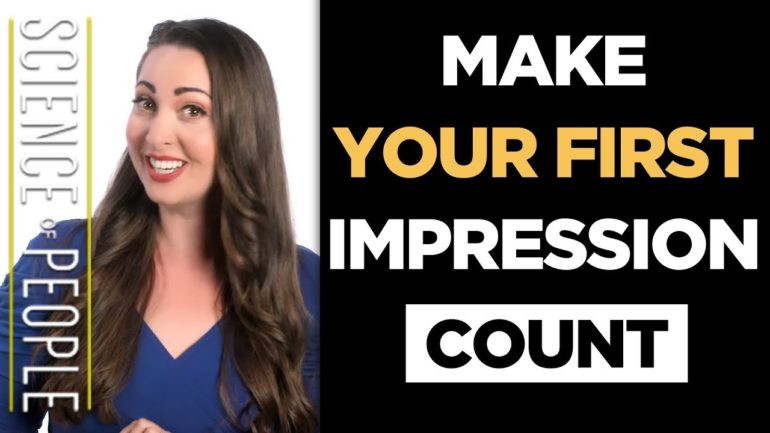First impressions are everything. You only get one chance to introduce yourself. Learn the science of first impressions to make yours count.
First impressions are everything.
The science proves it: most people make a first impression of a person within 7 seconds so you have to make it count. In this post, I want to teach you 21 science-backed strategies to make an incredible, lasting, captivating first impression.
How did I just do on mine? Good? Well, you’re still here, so good enough. Let’s dive in.
Whether you’re at a networking event, pitching your boss, or schmoozing at a party, you have to nail that first interaction… Because you might not get a second chance.
In this guide you will learn:
- how to make an awesome online first impression
- why first impressions can make or break you
- 6 surprising statistics about first impressions
- 21 steps to nail your first impression every time
- How to overcome a bad first impression
Let’s create an awesome first impression.
Why Are First Impressions Important?
A good first impression can land you a job, build stronger relationships, and even attract a partner. With a great start, you can strengthen your relationships and make future interactions go smoothly.
Studies have found that, on average, our first impressions of people are 76% accurate. This means we are pretty good at creating gut instincts.
How long does it take to make a first impression?
Research shows that most people make a first impression of a person within 7 seconds. Experiments by Princeton researchers even suggest that people can make accurate judgments of others within 1/10 of a second.
Here’s the good news: You have control over the first impression you make.
How to Make a Good First Impression Online
Nowadays, many people are making online video calls or emails a top priority. Whether you’re applying for a work-at-home job position, writing a professional email, managing a virtual team, or giving an online presentation, here are some tips that apply to the virtual world so you can make a great first impression:
- Step back. Who likes seeing a face up-close? A good rule of thumb is to keep your camera back at least a foot and a half.
- Wave hello. Since you can’t shake hands, my go-to is to wave hello. Waving is a great way to show friendliness and a great way to start any video call. It also shows your intentions and builds trust.
- Choose a clean background. Dirty clothes, unorganized shelves, and peeling paint—these can all give the wrong impression.
- Add front lighting. Have you ever gotten on a webcam and looked like a villain straight out of a Marvel movie? It could be due to your lighting. Professional light setups make sure lighting is in FRONT of you so your face is brightened. You don’t have to go professional, but whatever you do, make sure the light isn’t behind you.
- Look at the dot. Most people make the mistake of looking at the screen. But there’s a problem: no eye contact! Look straight into the webcam when saying your hellos to make a great first impression.
- Wear pants. You won’t believe how many people wear inappropriate shorts to a business call. Or even worse… no pants at all! Wearing appropriate attire not only gets you in the right mindset, but it also saves you from a potentially embarrassing situation.
If you’ve done hundreds (or even thousands!) of video calls like me, you might even be feeling video call fatigue. Luckily, we’ve got expert advice to combat Zoom fatigue, as well as more tips to perfect your next video call.
And what about your social media account? After you’ve made a good first impression, maybe you exchanged LinkedIn / Facebook / Instagram accounts.
But by the time you go home, the other person likely has already pulled up your account and browsed through your profile. This can be a blessing and add points to your overall first impression… Unless your profile looks something like this:

How to make a good first impression by email
Of course, I’m sure you already knew this, but grammar is super-important in emails. Grammarly reviewed 100 LinkedIn profiles of native English-speakers in the consumer packaged goods industry. The findings?
Professionals with fewer grammar errors in their LinkedIn profiles were promoted to higher positions. The ones who didn’t make it to director-level positions made 2.5 times as many grammar mistakes.
Fewer grammar errors correlate with more promotions. The professionals who only had 1 to 4 promotions over their careers made 45% more grammar errors compared to those who received 6 to 9 promotions.
But you probably didn’t need a study for you to know that grammar is important. Some people, like Kyle Wiens, CEO of iFixit, won’t even hire people who use poor grammar. Check your emails for proper grammar using tools like Grammarly—it might mean the difference between inviting someone out for lunch and eating them!
6 First Impression Statistics You Should Know
Numbers speak a lot more than words. Here at the Science of People Research Lab, we conducted a survey asking 209 people their opinions on first impressions.
Here are the important statistics you should know:
- 95% of people believe first impressions are very important.
- 61% of people believe they can instantly spot a “phony” the minute they meet him or her.
- 79% of people believe they usually or always make a good first impression.
- 68% believe their first impressions of others are accurate.
- 44% of people say the first thing they notice are the eyes when meeting someone.
- 40% of people say it takes them 7 seconds to make a first impression.
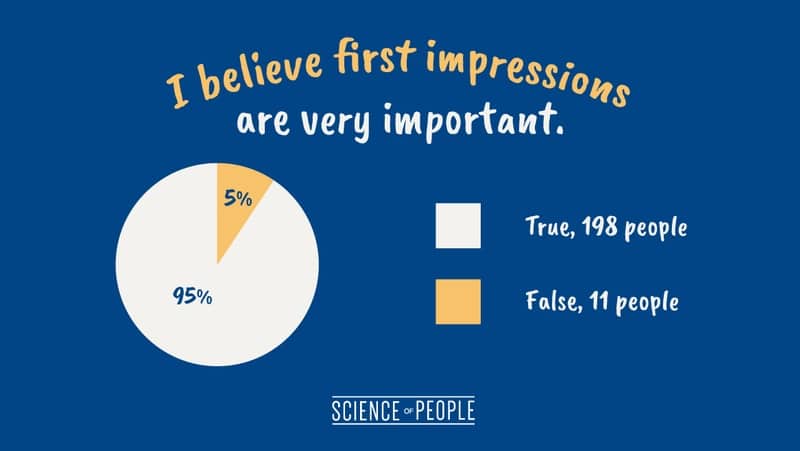
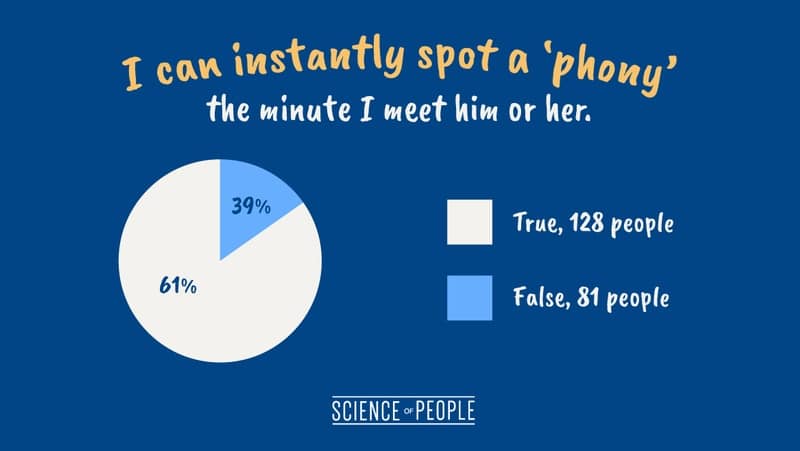
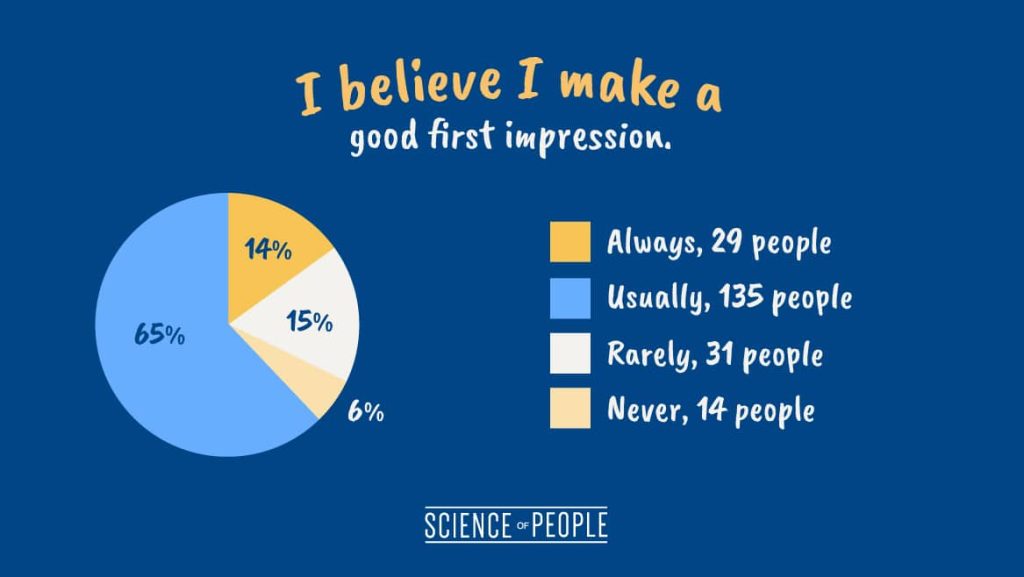
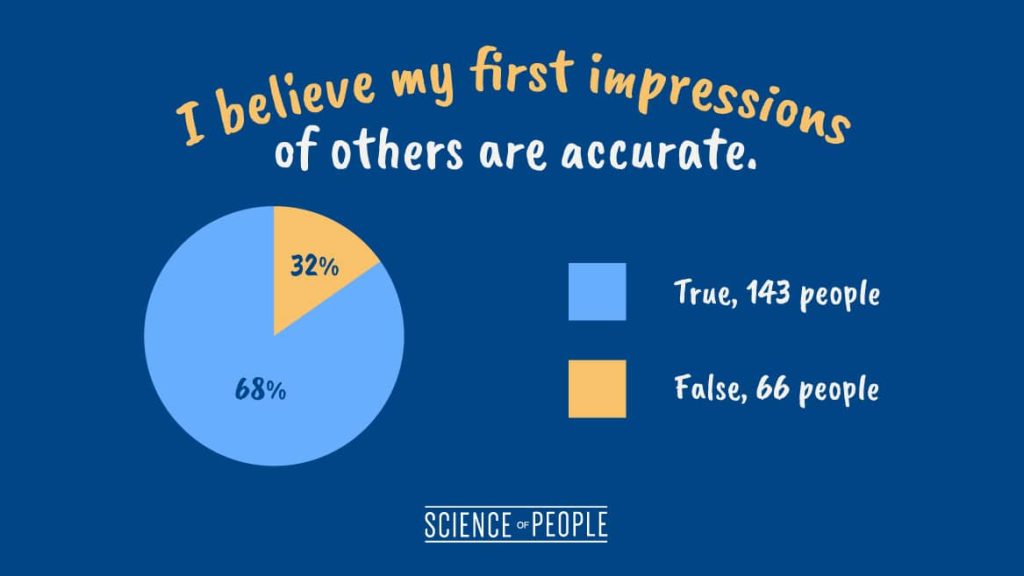
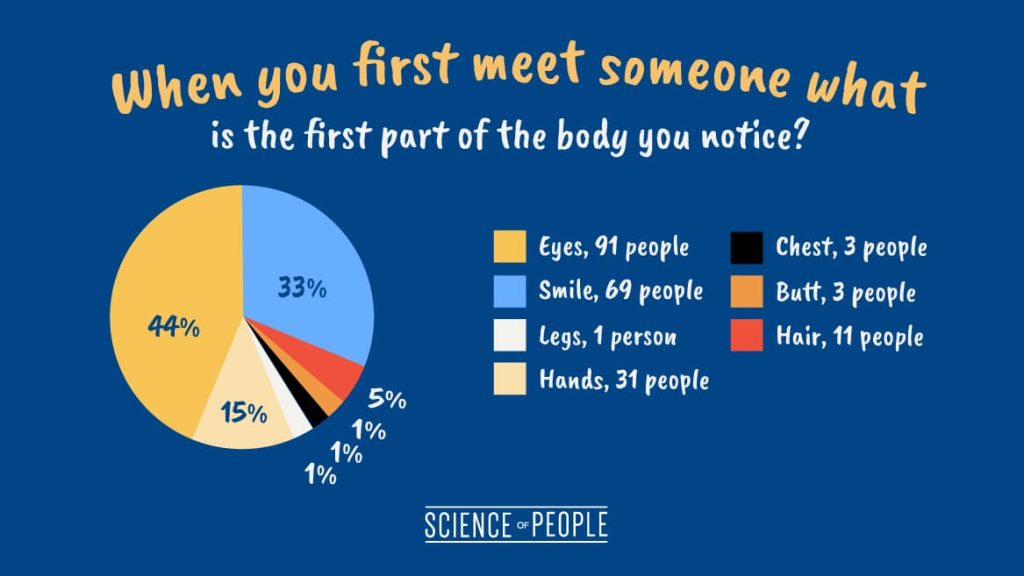
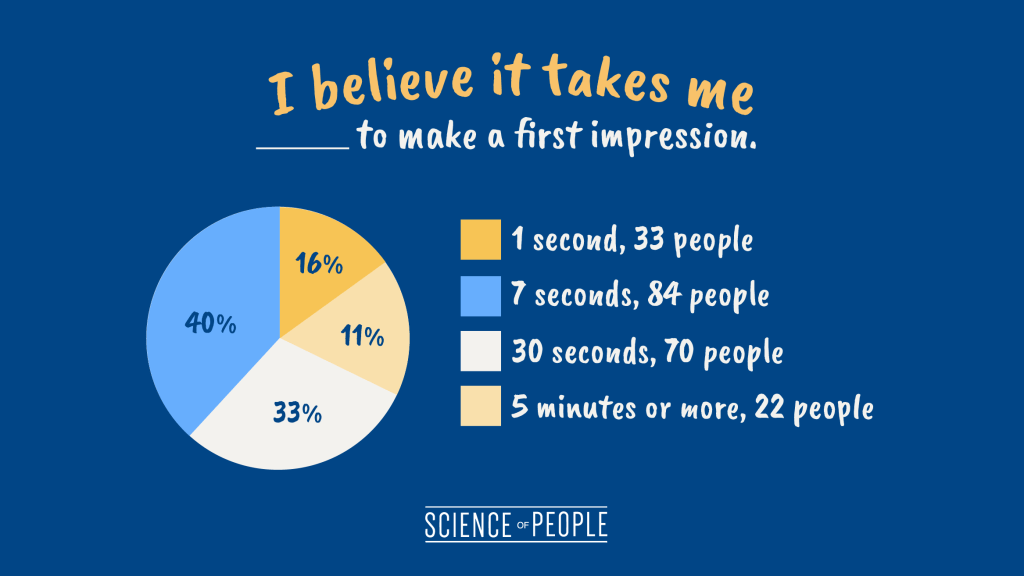
Step #1: Thin-Slicing
When it comes to first impressions though, it’s not just body language and your clothes that matter. Research shows that your facial features play a huge role in how people perceive you.
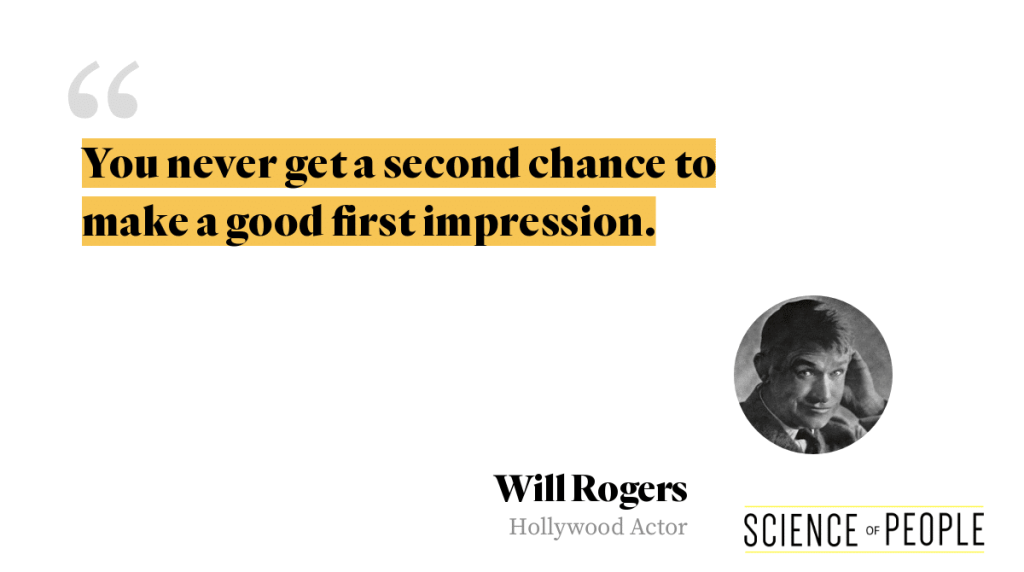
Watch my video to learn more:
Other studies have found that we not only decide if we like someone in the first few seconds, but also that the first impression stays with us.
Princeton University psychologist Alex Todorov had people look at a microsecond of video of a political candidate.
Amazingly, research subjects could predict with 70% accuracy who would win the election just from that microsecond of tape.
This tells us that people can make incredibly accurate snap judgments in a tenth of a second.
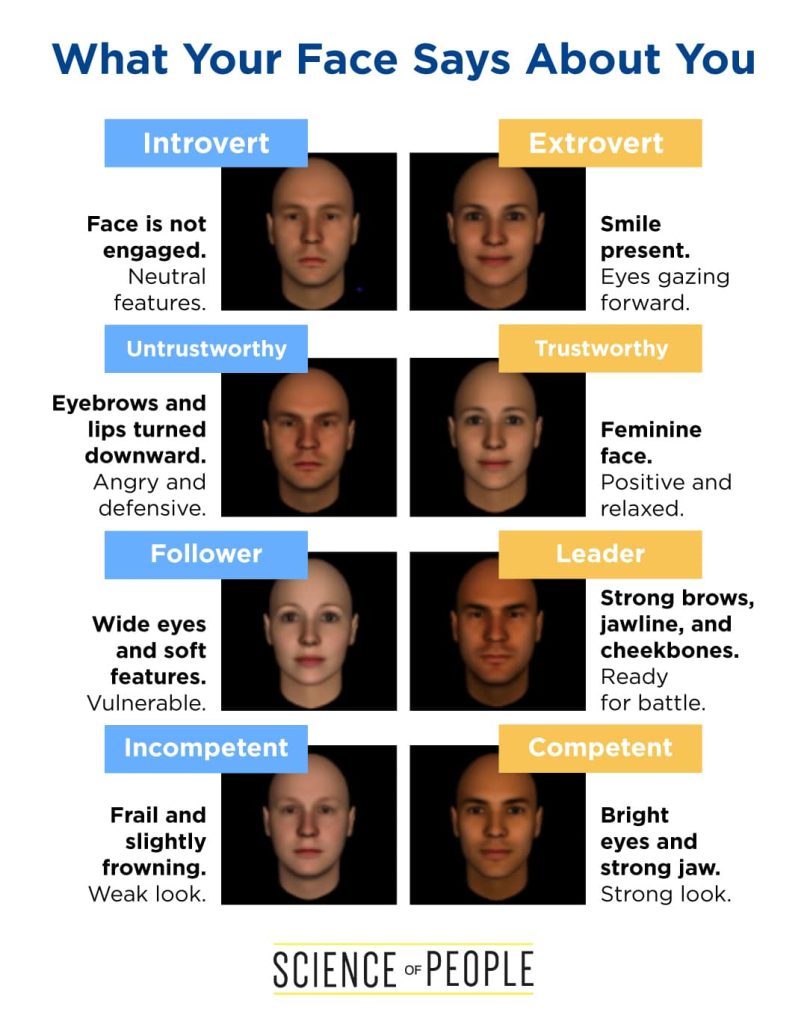
Making a good first impression is incredibly important for you because you only get one shot at it. I know this sounds harsh, but as humans, we are conditioned to judge people within the first second of meeting them—and our opinion often doesn’t change.
This is called thin-slicing.
So how does thin-slicing work? And why do we do it?
Malcolm Gladwell’s book, Blink, points to 3 important principles of thin-slicing you should know about:
We don’t judge without reason—thin-slicing helps.
Gladwell gives one example of the psychologist Nalini Ambady, who found that if she gave college students a silent two-second clip of a teacher to watch, they could then thin-slice the effectiveness of that teacher.
And the most interesting part is they came to the same conclusions about the teacher as students who sat in class with that teacher for an entire semester. This study shows that most of the time, your gut feeling may be right. If you’re walking down the sidewalk and another person approaches you, your gut instinct may kick in—and perhaps, it could even save your life.
I want you to think about how you’ve thin-sliced someone in your own life:
- Have you ever had a gut feeling about someone…and found out later you were right?
- Have you ever had a good feeling about someone…and found out later you were wrong? What happened?
- From now on, pay attention to your gut reaction the next time you meet someone new and then follow up with your gut. Were you right? Wrong? Start learning from your mistakes.
One of the most fascinating examples in the book is with Dr. John Gottman. He runs a “Love Lab” at the University of Washington and has been able to apply thin-slicing to videos of married couples talking, and turn them into a remarkably accurate marriage predictability tool.
If he watches a couple talk, not fight, just talk, for an hour, he has a 95% success rate in determining if they will still be married in 15 years. Yet, even if he watches for just 15 minutes, that rate is still at 90%.
Now, you might think Dr. Gottman is a savant when it comes to this kind of thing, that he has great gut instincts for interpersonal dynamics.
Not quite. It all boils down to what he calls, “the four horsemen:”
- Defensiveness
- Stonewalling
- Criticism
- Contempt
The one that really sticks out to Dr. Gottman, the feeling that can be thin-sliced out of all the thin-slicing is contempt.
What he really does, and teaches his students to do, is look for that tell-tale sign of contempt. When you’re able to focus in on one thing and know what you’re looking for, separating the signal from the noise so to speak, suddenly the answer appears.
To illustrate the point, Dr. Gottman’s divorce prediction test was re-worked and broken down by a group of psychologists. They came up with a list of things to look for, including the four horsemen, and then gave the videos and lists to non-experts.
These non-experts watched the videos in 30 second chunks, twice, using their list of things to look for and then were asked to predict.
The results?
The non-experts hit a just over 80% accuracy rate on which marriages were going to still be going strong in 15 years.
So, not only can thin-slicing be taught, but it turns out (unsurprisingly) we all have a little bit of it inside ourselves already. In fact, many of the experts were able to teach either Gladwell or someone else how to thin-slice effectively without incredible amounts of time or effort.
This plays right into the concept that we can actually tap into our unconscious and learn how to use it more effectively. The key is learning what exactly to look for. Here is what contempt looks like, a simple one-sided mouth raise:
Contempt Microexpression
Bottom line: People have their own inherent biases, so sometimes it might feel like a never-winning task to make a good first impression, no matter how hard you try. Don’t be hard on yourself! But that’s no excuse to be lazy. There ARE techniques you can use to change the way others perceive you, so you can have a slight edge when people make their snap judgments. But first, let’s turn within.
Step #2: Self-Evaluation
Let’s be totally honest right now. When people first meet you, What do you think they think of you? In other words, how do you think you come across?
If I had to describe my first impression in one word, I would say people see me as _.
Did you pick a positive word? Or a negative word? Our survey shows these were the most common words chosen:
- Friendly (18)
- Quiet (10)
- Nice (9)
- Confident (8)
- Shy (8)
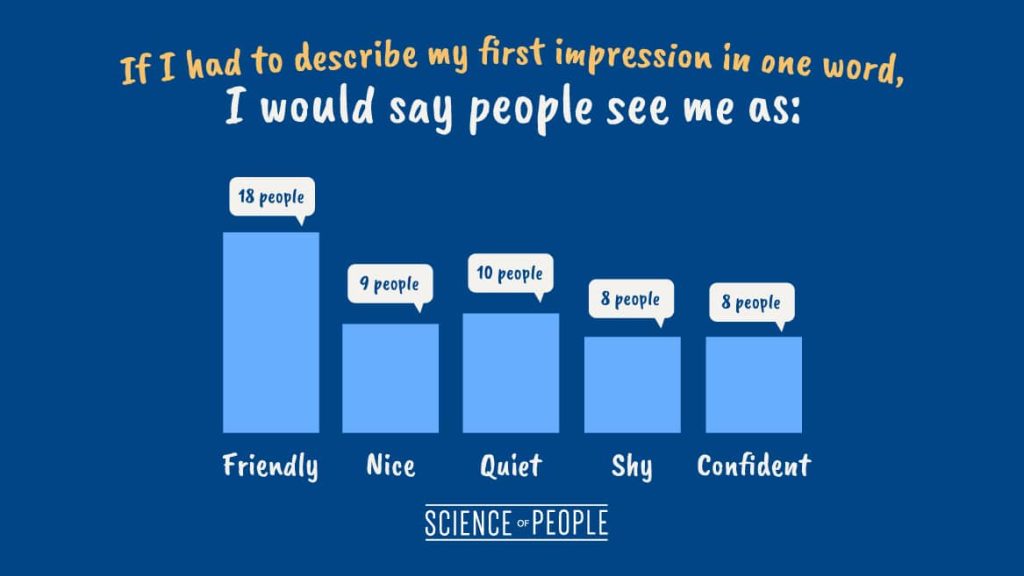
Now ask yourself this question:
If I had to describe my ideal first impression in one word, I would want people to see me as _.
Our results show that most people aspire to be:
- Confident (21)
- Charismatic (16)
- Friendly (14)
- Interesting (9)
- Kind (9)
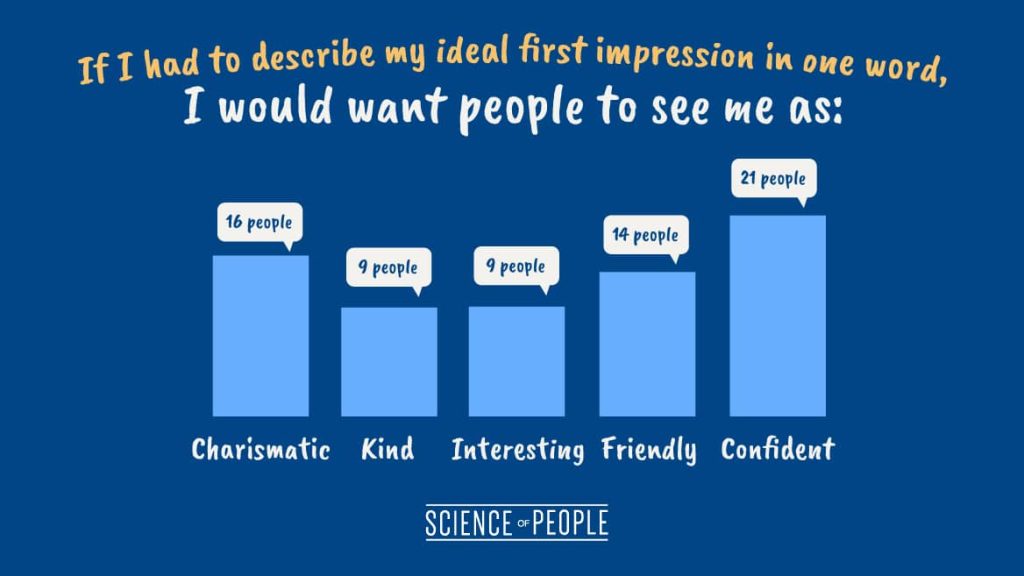
Is there a big gap between where you are now and who you want to be? If there is, you can work towards your goal by finding a role model and developing the habits and mindset that he or she has.
Step #3: Ideal Firsts
Have you ever played the board game, Perfection? It’s the game where you have a bunch of different shapes with the goal of fitting them inside their respective holes. I loved this game as a kid—I could literally spend hours fitting in the colorful yellow pieces and taking them out again.
Why am I talking about a little kids’ game?
Because much like these different shapes, you can’t make a good first impression with EVERYONE if you’re a triangle and you’re trying to fit with a square.
That’s why you always want to start on the right foot by first setting your intention before meeting new people—such as in conferences, networking events, or parties.
As you get ready to meet someone, think about what kind of people you want to meet and what kind of interactions you want to have. This can be an incredibly grounding experience and works very well to focus what kind of energy you want to have for your event.
Remember—61% of people believe they can instantly spot a “phony”’ the minute they meet him or her, so your best bet is to avoid people-pleasing and be the best version of yourself.
Right now pick your ideal first impression word.
When people first meet me, I want them to see me as_______.
Having this intention clearly in your mind will help you come across as that.
Step #4: Hands First
Where do you look when you first see someone? I asked the audience this in my TEDx Talk and most people said: eyes, face… and shoes. But the answer is…
Hands! Two important things to note here:
- We LOVE seeing someone’s hands right away. It makes us feel safe. So whether you are on video, in a restaurant, or walking into a crowded party, keep your hands out of your pockets and visible. Ideally give a little wave.
- We also love hands to gauge understanding. When you speak with your hands, we are able to comprehend and remember more.
In fact, we analyzed thousands of hours of TED talks and found one striking pattern: The most viral TED Talkers spoke with their words AND their hands.
The least popular TED Talkers used an average of 272 hand gestures during the 18-minute talk.
The most popular TED Talkers used an average of 465 hand gestures—that’s almost double!
Hands can be flying around the air, frozen to the side, or as floppy as a fish trying to get back into water. But the masters of hand movements use the right movements—and they use them frequently.
Step #5: Use the Eyebrow Flash
The eyebrow flash is a commonly used greeting people use when they recognize each other—it shows you are happy to see them.
It’s also universally-recognized even in isolated tribes, according to a 1989 study. The Peases mention that monkeys and apes use it, suggesting that it’s an inborn, evolutionary gesture.
But you can also use it when meeting new people. This gives them a feeling of familiarity and closeness, since people typically only use this gesture when they know each other.
Here’s how to do the eyebrow flash:
- When you first see someone you want to make a good first impression with, make eye contact and immediately raise both your eyebrows.
- Make it a quick up-and-down—hold it for too long and you’ll risk looking like a scared deer in the headlights.
Here’s the Golden Rule for eyebrow flashing: always make sure to eyebrow flash the people you like or who you want to make a good impression with.
Step #6: Put On a (Real) Smile
Here’s a simple task for you: Smile! Oh, c’mon. As a professional behavior investigator, I can tell you’re not really smiling. Really smile this time—I know you can do it!
Well, how did you do? If you’re like most people who are forced to show their pearly whites… you did what most people do—fake a smile by pulling up the corners of their mouths.
But I’m going to teach you how to replace your fake smile with a real, genuine one so people actually FEEL good when they see you. And the trick is actually quite simple.
According to our survey, 33% of people said a person’s smile was the first thing they noticed in a first impression.
First, here’s what a fake smile looks like vs. a genuine, real smile:


Can you see the difference? On the left picture—sure, I’m smiling and you can see my pearly whites. But my eyes are saying, “Oh no. Not YOU again. Please, can someone come over and save me!?”
On the right picture—my mouth is in a full grin, pulling my cheeks up so much you can even see the crow’s marks around my eyes—or what the science world calls the “Duchenne Marker”.
Here’s the key difference: The Duchenne marker is what separates most fake smiles from real ones. And here’s a juicy, top-secret hint (please don’t let it get in the hands of your enemies): a real smile can actually be faked.
Wait, WHAT!?
It’s true: In a 2009 study, participants were given a picture of someone smiling with a genuine Duchenne smile. And here’s the kicker: when researchers told the participants to copy it, 71% of them accurately replicated it (and chances are, you probably can, too!).
But here’s the thing: The study also showed that most people who viewed pictures of Duchenne smiles vs fake smiles agreed the Duchenne smile is more authentic (even if it’s faked), while the “fake” smile is not.
In other words…
People can’t tell if you fake a real smile. Yet, you can make a long-lasting impression if you pull it off when greeting someone.
So if you want to stand out above the crowd, here are 3 steps to pull off that genuine smile in every social situation :
- Think of something really funny (having a hard time? Check out our laughter lunch article).
- Smile—preferably in front of a mirror feeling your cheek muscles moving up.
- Make that smile lift higher, bringing your cheek muscles up until your eye muscles are crinkled.
Voilà! You’ve done it. A great, dazzling smile you can use when meeting people that’ll leave a wonderful first impression.
Step #7: Perfect Your Handshake
A handshake, which occurs at the beginning of almost every business transaction or meeting, tells you more than you realize.
Research has found that people can judge our personality from handshakes alone. What does yours say? Be sure to get it right with our steps. A handshake is the first nonverbal touchpoint you have with someone. When talking about first impressions, we have to focus a lot on the nonverbal. Why? Our nonverbal signals are 12 to 13 times more influential than accompanying words.
Our goal is that your nonverbal shows whoever you’re interacting with that you’re calm, confident, and powerful. How do you do this? With a launch stance.
Step #8: Stand in a Launch Position
“Straighten your back!”
“No elbows on the table!”
“Don’t forget to eat your peas!”
Oops, sorry there. I was having flashbacks from my mother for a moment. And if you’re anything like me, you might have heard these phrases in your household when growing up—or even still do.
But your stance is actually more important than your posture. And there’s one very powerful way you can stand to dramatically make a difference in your first impression.
I call it your launch stance. Your launch stance has 5 focal points:
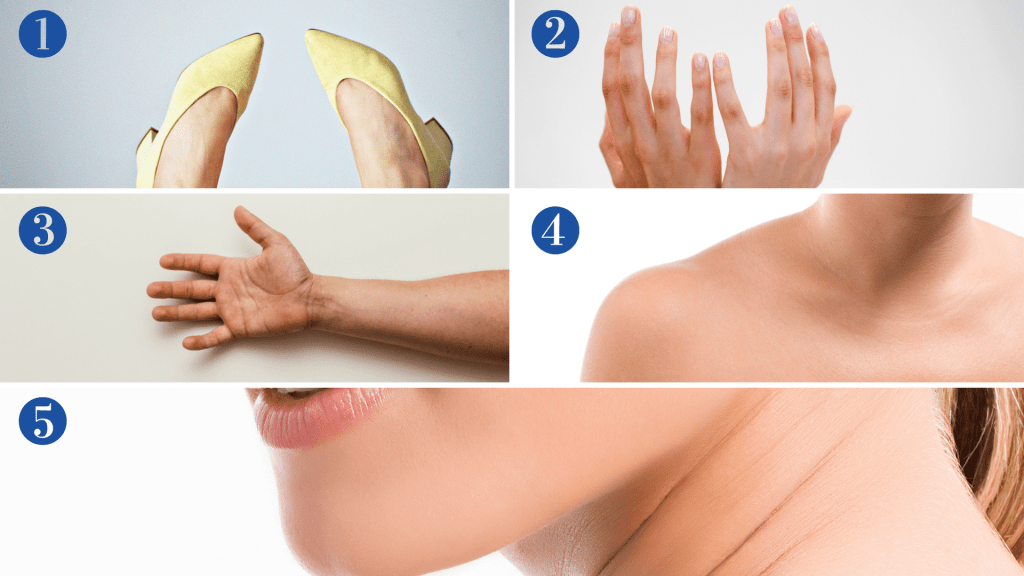
Toes
If your toes are pointed toward someone, it means that you’re interested in hearing what he or she has to say. Even if you’re sitting, it’s important to point your toes towards them to show interest in them.
Hands Your hands should always be visible and ideally open as you speak. Biologically, we feel fear when we see someone’s hands are concealed—as if they may be hiding a weapon. Hand gestures (covered below) should also be utilized.
Arms
Arms should always be loose so there is enough space between your torso and arms. This helps prevent you from leaving your arms dangling at the side, and lets you easily gesture and reach out to shake hands.
Shoulders
Shoulders should be down and back so they look nice and relaxed. The ideal angle for your shoulders depends on who you’re speaking with—if speaking to a woman, having your shoulders parallel to theirs is fine. Men may be more comfortable standing shoulder-to-shoulder rather than directly in front of you.
Chin
Your chin should ideally be neutral so you are not looking up at someone or sneering down at them. However, body language experts Barbara and Allan Pease have noted that women who lowered their chin while looking up at men appear smaller (and thus more feminine), while men who angled their chin upwards when talking to women appeared taller, thus creating greater attraction.
Your toes, hands, arms, shoulders, and chin probably were not the body parts you were thinking of during a first impression. But they should be! These are also what you want to focus on while taking the perfect selfie!
Step #9: Give Them a Coffee
Oh, but what if you’re standing there in your perfect Launch Position, ready to give the best impression ever—but the other person has his or her arms crossed?
Crossed arms is one of the biggest body language barriers to look out for—arms are basically a big barrier to deep connection, and you can bet if someone crosses their arms while talking to you they’re not willing to open up.
So here’s what you can do: give them something to hold. A coffee. A business card. A pen. Anything that forces them to open up.
Why does this work? Because we feel through our bodies:
- Forcing a smile actually makes you happier.
- Distancing yourself from others makes you feel more isolated.
- Crossing your arms makes you feel more closed off.
More body language tips can be found in our Body Language Guide.
Step #10: Use Your Ideal Voice
“I urge you to vote for me this November.”
This was the phrase that researchers at Duke University and the University of Miami asked participants to say to find out exactly what makes a voice so likable. The study went like this:
- Both men and women were recorded saying the above phrase.
- Their voice was then digitally manipulated to be either a higher- or lower-pitched version of the original.
- Different men and women were then asked to vote which voice they thought would make a better leader.
Can you guess which voice won out? Was it the lower-pitched voice, or the higher one?
If you guessed lower-pitch… Bingo!
And here’s the most interesting part: you might think that people preferred higher-pitched women’s voices. In actuality, BOTH men’s and women’s lower voices were more favored than their higher-pitched voices.
Lower-pitched voices were voted more favorably than the higher-pitched voices, for both men and women.
But you probably shouldn’t fake a deep voice and run around talking to people like you’re Frankenstein, right? Alas, we have something called your maximum resonance point! This is your ideal vocal range where your voice shines, sounds like a leader, and most importantly—you sound natural!
You should aim to speak in this range—and even err on the lower end of your range if you want to make a great vocal impression that people will vote for. This is also a great tip if you have a phone interview or video call!
Step #11: Repeat Their Name
One of my all-time favorite books, How to Win Friends and Influence People by Dale Carnegie, has an awesome tip that I use in every single conversation: use the other person’s name.
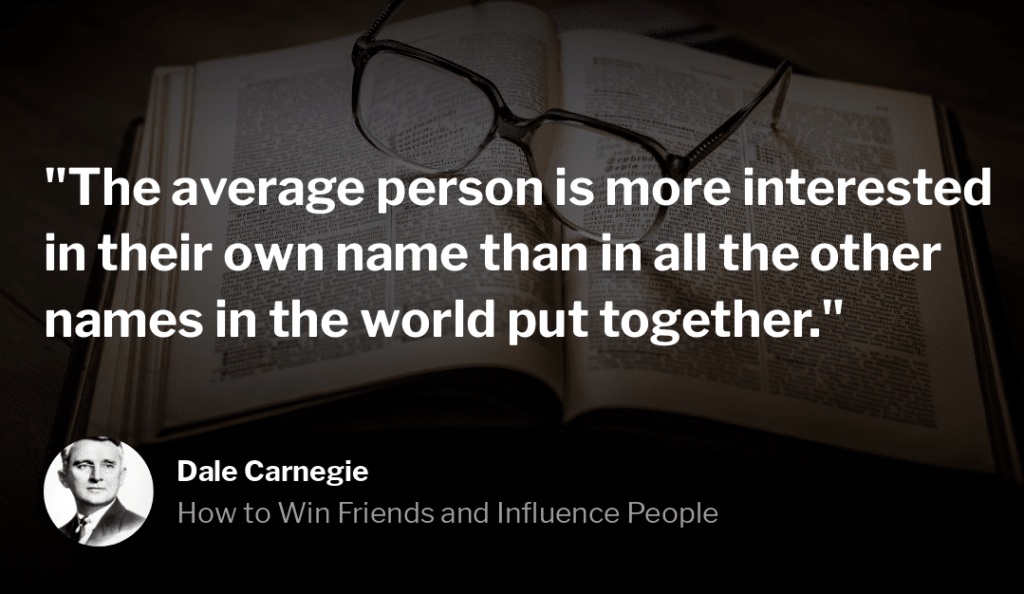
Here’s the science: when someone hears their own name, unique parts of the brain are activated. But they’re not when hearing others’ names. Use this to your advantage to name-slip someone’s name during your conversations!
Here’s how to do it: Right after the person introduces him- or herself, I like to immediately repeat their name: “John, it’s a pleasure to meet you!” Sprinkling in their name throughout the conversation every few minutes also keeps that dopamine boost going:
- “John, I have a friend I want to introduce to you.”
- “That’s a really good insight, John.”
- “Nice to meet you, John!”
Fun fact: Even cats can distinguish their own name, according to a Japanese study.
Step #12: Copy Their Lingo
You know the phrase, “Sticks and stones may break my bones, but words can never hurt me”?
I have to say… Words CAN hurt. And they can even create stronger emotions, if you know the right magical words to say.
Behavior expert Chase Hughes mentions 2 important types of words you can use to instantly build rapport with anyone you meet: sensory and adjective words.
The first group of words is sensory. People use different types of words depending on how they best experience the world based on their senses or primary intelligence type.
In other words, most people favor one of their 5 senses more than the other ones. For example:
- Hearing: A musician may use phrases such as, “That sounds great” and “I hear what you’re saying.”
- Touch: A personal trainer might use phrases like “I feel you,” “I’m touched,” and “That rubs me the wrong way.”
- Sight: A painter may use, “I can see that,” “It looks good,” and “eye-to-eye.”
If you hear your conversation buddy using one of these phrases, you can also use similar sense lingo to get on their good side. In fact, I used this same technique just last week when I got off a Zoom call with a team member. It went something like this:
- Kensi: “OK, sounds good!”
- Vanessa: “Great! I can’t wait to hear back from you!”
The next group of words stands for adjectives. You know how some people LOVE to use certain adjectives in their vocabulary, like “amazing,” “cool,” or “super”?
Good news is, you can also use their positive words to make things even more… er, positive! Here’s a story of how I used someone else’s lingo to gain rapport:
A while back, I met this one woman named Sarah at a networking event. We got on the topic of other interesting people we met at the event, and I noticed she would always sprinkle in the word “cool” whenever she mentioned someone positive. When it was my turn to talk about people I connected with, I also threw in the word “cool” to match her positive lingo. I immediately noticed her eyes light up whenever I used the word. It worked so well that we ended up having dinner afterward—Sarah and I even keep in touch to this day!
And you can even use this same technique with negative words, using their same negative lingo to describe things you both dislike.
Step #13: Start Amazing Conversation
Whew! So you got a grip on your nonverbals. Nice—so how do you have non-awkward, anti-boring conversations?
It turns out, the art of sparking amazing conversations is one of the most highly-requested topics at the Science of People. And I want to help you get started today. You don’t have to be naturally-charismatic or a gifted speaker—anyone can learn to hold sparkling conversations and win people over!
Step #14: Crack a Joke
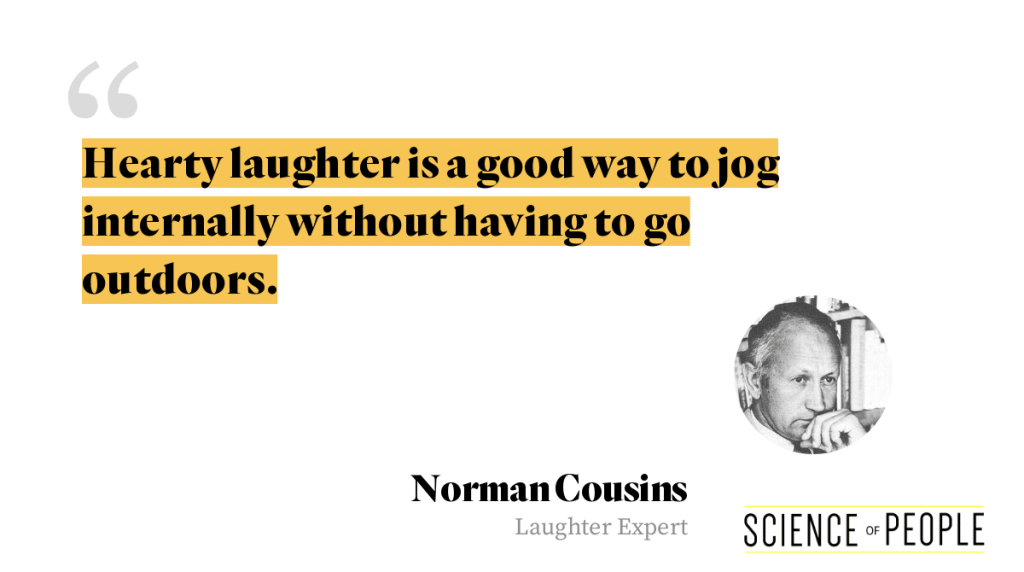
It was 1964, and Norman Cousins refused to die. He was diagnosed with a life-threatening disease that would give him only a few months to live.
According to the doc, it was a clear-cut case of ankylosing spondylitis. Or, in English, a lifelong condition that causes pain and stiffness in the spine.
Horrified with this newly-diagnosed condition, Norman refused to believe this was the end of his life. He was determined to live.
Norman was desperate and traditional medicine wouldn’t help, so he decided to turn to laughter. He rented every funny video he could find, rewatched and watched them, laughing out loud for 6 months in his self-imposed “laughter therapy.”
And the miracle that doctors couldn’t believe happened:
Norman’s life-threatening disease had completely vanished, all because of laughter.*
According to the Peases, this was in part due to the flood of endorphins we receive when laughing—endorphins that are similar to the drugs morphine and heroin. The endorphins act as a tranquilizer and build up the body and its immune system. This is also why happy people rarely get sick, and people who complain a lot are the ones who often get ill.
In your first impressions, humor should be a top priority.
How to Be Funny
*Note: If you have a serious medical condition, it’s still probably wise to consult a medical professional instead of using laughter therapy.
Step #15: Make Them Feel Important
In the book, Million Dollar Habits, Brian Tracy tells of a tale called The Arabian Nights, which tells of a huge cave full of treasures that can only be opened on one condition—one lucky person must say the magical words, “Open Sesame!”
Once uttered, the vast wall would finally open, revealing the unlimited treasures hidden inside.
And guess what? There are also magical words you can say to other people, revealing their “treasures” of warm emotions and fuzziness.
According to Tracy, these words are words that make others feel important and strike at their emotional chords.
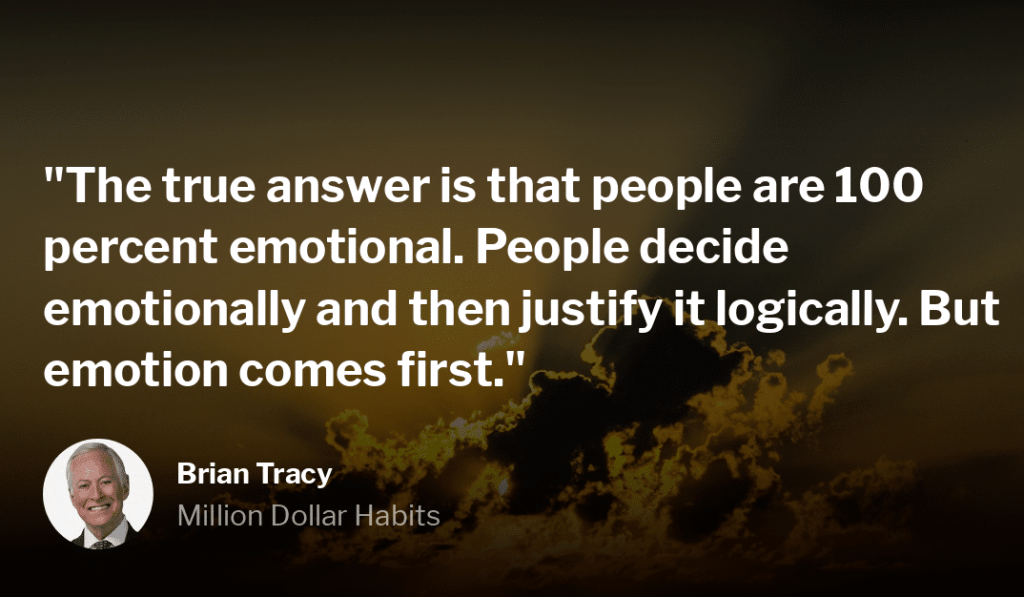
One of the best ways I have found to make others feel this important is to give compliments.
Studies even show that giving someone a compliment activates the same neurons in our brain as receiving a physical gift.
But you can’t just give compliments out like candy, nor can you keep cookie-cutter compliments in your back pocket and pull them out willy-nilly—imagine if you complimented a bald guy on his hairstyle!
The key to compliments is genuineness—people can sniff a fake compliment a million miles away. Compliment someone on their new shoes, their physique, their way of thinking. Anything is fair game, as long as you really mean it.
Step #16: Pick Your Ornaments
Clothes, makeup, jewelry, watches, and shoes are all types of ornamentation, and people definitely take these into account when making initial judgments.
I highly recommend getting some of your favorite outfits or ornaments together and asking friends you trust what they think of when they see them. For many men, they do not realize that their watch can say a lot about them. For women, purses and large earrings or jewelry can also have unintended meaning to a new person they are meeting.
Here are 6 appearance hacks you can use to make a great first impression:
- Chew gum. Did you know, contrary to popular belief, chewing gum has a lot of positive perceptions attached to it? Uh-oh, all those mommas who told their kids to spit out their gum when talking might have been wrong. Food company Beldant conducted a study of 481 participants, in which 73% favored those who chewed gum and associated it with a ton of positive traits. People thought those who chewed gum:
- Got invited to more parties
- Had more friends
- Would seem more likely to give them a raise (if they were the boss)
…and even had a better sex life
Just make sure not to chew gum during an interview. You can watch the interesting experiment below:
- Dress to impress. In a 2012 paper by Hajo Adam and Adam Galinsky, the idea of “enclothed cognition,” ie, whether our clothes affect our thoughts, was studied. In one experiment, participants wore either a doctor’s coat or a painter’s coat, and the group wearing the doctor’s coat performed better at tasks all across the board!
- Wear makeup. If you’re a woman, in most cases makeup will help you. In an experiment by the Peases, 4 similar-looking female assistants were hired to help sell their training products at a seminar. However, some were wearing makeup and/or glasses, and the others weren’t. The assistant wearing both makeup and glasses were described as confident, intelligent, sophisticated, and the most outgoing; however, some female customers saw her as confident but also cold and arrogant as they saw her as “competition” rather than a possible friend. And, not surprisingly, assistants who wore no makeup were rated the worst.
- Find your fragrance. In a 2016 study, 67 observers assessed samples of odors from 113 odor donors, who each provided one sample without cosmetics and another sample with it. The observers rated the odors with cosmetic fragrance as more attractive and pleasant than those without them. And if you’re wondering which perfume to use, it’s best to go with a typically masculine-smelling cologne if you’re a man, and a feminine perfume if you’re a woman, according to a study from researchers at Northumbria University. They found that gender-congruent fragrances can increase the perception of certain socially desirable characteristics, such as intelligence.
- Wear glasses. Another twin study conducted by eye company Execuspecs found that 76% of people who watched twins on television favored the twin that wore glasses (surprise: the “twins” were actually the same person). Glasses were associated with higher income, better time management skills, and better computer-solving abilities
- Ditch the piercings. For men, studies show that wearing jewelry lowers credibility and nose rings decrease hireability. Another study found that patients associated nontraditional piercings negatively in regards to a physician’s competence and trustworthiness.
Important note: Context matters when dealing with your appearance. It might be a great idea to don your expensive suit and Rolex when interviewing for a job position at Charles Schwab. But do that in a relaxed college campus environment? You might come off as too show-offy and rub people the wrong way. It might be a good idea to play “chameleon”— that is, dress like how others are going to dress.
I have my 10 favorite clothing hacks you can learn as well. Make sure that what you are wearing and how you do your hair or makeup says what you WANT it to say to the people you are meeting for the first time. Even colors tend to have different meanings.
Step #17: Avoid Your Bad Days
Believe me, I want you to socialize. But I also want you to do it on your time. You might think that going out will make you feel better. But in my experience, people who go to cocktail events or mixers after having had a bad day typically continue to have a bad day.
If you are in a depressed or anxious mood, others will pick up on this from your facial expressions, comments, and body language. You might even leave the event feeling more negative than if you stayed inside!
So here’s my plea for you: If you’re having a bad day, stay home!
There is almost no way to make a good first impression if you are having a bad day. If you have to go to an event, find a way to snap yourself out of your bad mood. I find working out, calling a friend, or watching funny or inspiring TED talks before events often gets me in a more social, feel-good mood.
Check out my video on pre-performance rituals to get pumped up:
Step #18: Have a Great LAST Impression
How many times have you wanted to end a conversation, but it turned out something like this:
- “Hey, so… Gotta run, hahaha…”
- Nervous glances towards the exit
- Nodding your head in uncomfortable silence
This is a GREAT way to make an awkward first impression, no matter how many good things you ticked in your conversation.
I’ve made so many awkward fumbling exits and learned the hard way—so you don’t have to. I hope this video and guide can help you masterfully and graciously end ANY conversation:
How to Fix a Bad First Impression
Okay, so you’ve made a bad first impression. No worries! We’ve all been there. Here’s the good news: You CAN fix a bad first impression! Here’s a story where I overcame a bad first impression:
So the other day, I ran into someone I haven’t seen in a couple years. Immediately, I was struck with anxiety, nerves, and insecurity.
Why?
I realized the very first time I met him, I did not make a good first impression. I was having one of those days where I should have just stayed at home, ate ice cream, and watched Netflix.
But—nope! Instead, I was like, “I better go to this networking event because I signed up and spent 5 whole dollars!”
So I went to the networking event and was drained and tired. Long story short, it was not so pleasant. I realized I had to overcome a bad first impression. Here’s how to recover from a bad first impression:
- Acknowledge the bad. Don’t shy away from the bad first impression. If you show you’re not afraid of talking about the bad first impression you made, you show a little vulnerability. And you might even be able to look back and laugh at it!
- Change the setting. Sometimes a bad first impression can be hard to overcome if you’re at the same or similar place as where you made it. Try going to a different setting! It can totally change the interactions you have.
- Ask for help. The “Franklin Effect,” named after Benjamin Franklin, is a psychological effect that makes people like you more! Ask them for help, advice, etc. and you’ll not only receive their tips, but bond together in the process!
- Stop the social scripts. Social scripts are the same boring convo phrases we’ve all heard before. “What do you do?” “Where are you from?” These questions are boring because we’ve all heard them before, and nothing NEW is activated in our brains. Instead, you want to trigger dopamine by asking a great conversation starter.
- Tell them you like them. This might sound counterintuitive, but science shows telling people you like them actually strengthens relationships! Most people withhold their fondness for each other, but that also makes the other person you’re conversing with withhold their feelings, too! I don’t usually say “I like you” straightforwardly, but I’ll do it more subtly—for example, by texting them, “I was just thinking about you” after our initial conversation. The key here is actually being genuine, so don’t say it if you don’t mean it!
What’s Comes After a Captivating First Impression?
Don’t be boring. I want you to have stimulating, eye-opening and FRICKIN’ fascinating first impressions and conversations.

